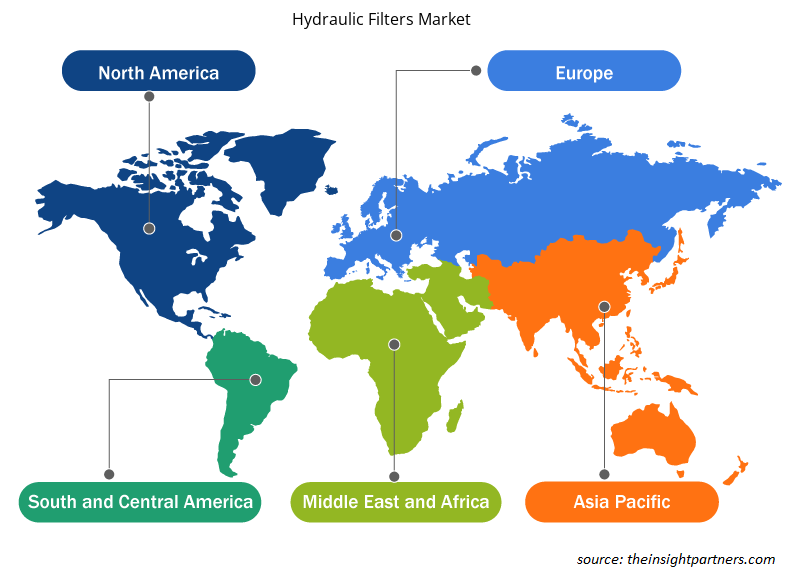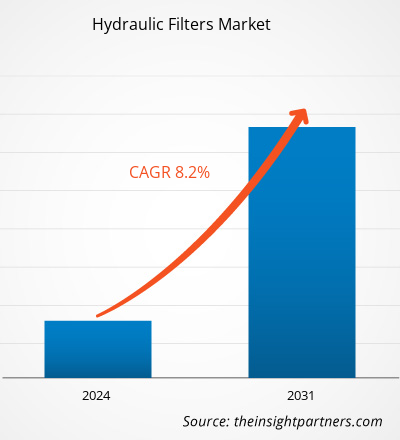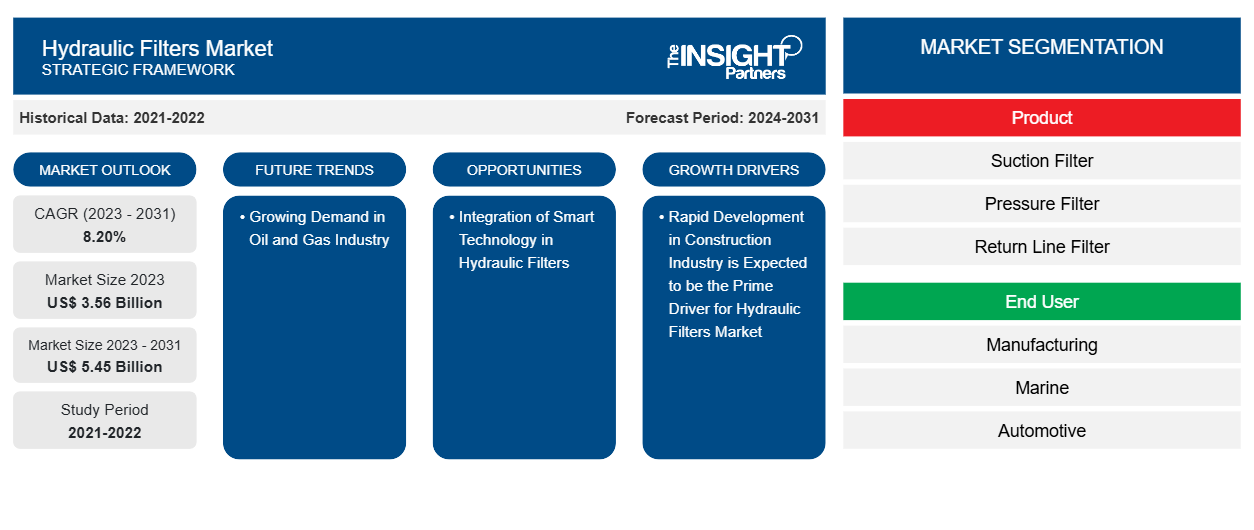Se prevé que el tamaño del mercado de filtros hidráulicos alcance los 5.450 millones de dólares estadounidenses en 2031, frente a los 3.560 millones de dólares estadounidenses en 2023. Se espera que el mercado registre una CAGR del 8,20 % entre 2023 y 2031. Se prevé que la creciente aplicación de filtros hidráulicos en los sectores de fabricación, construcción y transporte impulse el crecimiento del mercado de filtros hidráulicos durante el período de pronóstico.
Análisis del mercado de filtros hidráulicos
Los filtros hidráulicos son sustancialmente móviles y requieren menos tiempo para su instalación en varios sitios de fabricación y construcción. Los filtros hidráulicos ayudan a clasificar el aceite para eliminar la suciedad y los elementos. La eficiencia operativa del filtro hidráulico se evalúa por la velocidad a la que se elimina de manera eficiente la contaminación, como la alta capacidad de retención de suciedad. Creciente. Los sectores de minería, petroquímica y maquinaria de construcción en constante cambio han aumentado la demanda de filtros hidráulicos en todas las principales economías. Las ventas de filtros hidráulicos se ven impulsadas aún más por factores como la expansión de las actividades industriales y la creciente urbanización, junto con un aumento en la utilización posterior y la creciente demanda de petróleo en muchas naciones. Las crecientes preocupaciones sobre las operaciones efectivas en las industrias han expandido el comercio de filtros hidráulicos, lo que, a su vez, está impulsando el crecimiento del mercado global de filtros hidráulicos.
Descripción general del mercado de filtros hidráulicos
El rápido aumento de la producción de vehículos a nivel mundial está impulsando la demanda de filtros hidráulicos. Los factores restrictivos, como el complicado proceso de instalación de los filtros hidráulicos, pueden obstaculizar el crecimiento del mercado mundial de filtros hidráulicos durante el período de pronóstico. La digitalización ha aumentado la competencia de las máquinas predominantes y se prevé que aumente la demanda de filtros hidráulicos a nivel mundial. Además, se prevé que las crecientes actividades mineras y el desarrollo de la infraestructura impulsen el desarrollo del mercado de filtros hidráulicos durante el período de pronóstico.
Personalice este informe según sus necesidades
Obtendrá personalización en cualquier informe, sin cargo, incluidas partes de este informe o análisis a nivel de país, paquete de datos de Excel, así como también grandes ofertas y descuentos para empresas emergentes y universidades.
-
Obtenga las principales tendencias clave del mercado de este informe.Esta muestra GRATUITA incluirá análisis de datos, desde tendencias del mercado hasta estimaciones y pronósticos.
Impulsores y oportunidades del mercado de filtros hidráulicos
Se espera que el rápido desarrollo de la industria de la construcción sea el principal impulsor del mercado de filtros hidráulicos
Los filtros hidráulicos ayudan al funcionamiento eficiente de la maquinaria de construcción y funcionan junto con una amplia gama de bombas, válvulas y actuadores. Las inversiones sustanciales en el desarrollo de infraestructura por parte de los gobiernos a nivel mundial están aumentando simultáneamente la demanda de equipos hidráulicos como bombas, cilindros, motores, válvulas, grupos electrógenos y filtros. Por lo tanto, se espera que el rápido desarrollo en el sector de la construcción impulse el crecimiento del mercado de filtros hidráulicos durante el período de pronóstico.
Integración de tecnología inteligente en filtros hidráulicos
La penetración de dispositivos habilitados para IoT en los sectores residencial, comercial e industrial está aumentando a nivel mundial. Como resultado, los fabricantes de filtros hidrónicos están brindando a sus clientes soluciones únicas y desarrollando filtros hidrónicos inteligentes que se pueden integrar en infraestructuras inteligentes. Los filtros hidrónicos inteligentes utilizan las características de Internet, como las capacidades de análisis de datos de monitoreo en tiempo real para aumentar la eficiencia operativa.
Análisis de segmentación del informe de mercado de filtros hidráulicos
Los segmentos clave que contribuyeron a la derivación del análisis del mercado de filtros hidráulicos son el producto y el usuario final.
- Según el producto, el mercado de filtros hidráulicos se ha dividido en filtros de succión, filtros de presión, filtros de línea de retorno, filtros fuera de línea, filtros de ventilación y otros. El segmento de filtros de línea de retorno tuvo una mayor participación de mercado en 2023.
- En términos de usuario final, el mercado se ha segmentado en manufactura, marina, automotriz, química y petroquímica, generación de energía , agricultura, construcción, metal y minería, entre otros. El segmento de manufactura dominó el mercado en 2023.
Análisis de la cuota de mercado de filtros hidráulicos por geografía
El alcance geográfico del informe del mercado de filtros hidráulicos se divide principalmente en cinco regiones: América del Norte, Europa, Asia Pacífico, Medio Oriente y África, y América del Sur.
América del Norte dominó el mercado de filtros hidráulicos en 2023. La región de América del Norte incluye EE. UU., Canadá y México. El crecimiento del mercado de filtros hidráulicos en América del Norte se atribuye al creciente desarrollo del sector de la construcción junto con la creciente demanda de filtros hidráulicos en el sector manufacturero, lo que contribuye al crecimiento del mercado de filtros hidráulicos en América del Norte. Los filtros hidráulicos se utilizan mucho en entornos de alto riesgo, como la recuperación de petróleo y gas, las operaciones mineras y los sitios de construcción. El creciente apoyo gubernamental a través de incentivos y subsidios está teniendo un impacto positivo en el mercado de América del Norte.
Perspectivas regionales del mercado de filtros hidráulicos
Los analistas de Insight Partners explicaron en detalle las tendencias y los factores regionales que influyen en el mercado de filtros hidráulicos durante el período de pronóstico. Esta sección también analiza los segmentos y la geografía del mercado de filtros hidráulicos en América del Norte, Europa, Asia Pacífico, Oriente Medio y África, y América del Sur y Central.

- Obtenga datos regionales específicos para el mercado de filtros hidráulicos
Alcance del informe de mercado de filtros hidráulicos
| Atributo del informe | Detalles |
|---|---|
| Tamaño del mercado en 2023 | US$ 3,56 mil millones |
| Tamaño del mercado en 2031 | 5.450 millones de dólares estadounidenses |
| CAGR global (2023 - 2031) | 8,20% |
| Datos históricos | 2021-2022 |
| Período de pronóstico | 2024-2031 |
| Segmentos cubiertos |
Por producto
|
| Regiones y países cubiertos |
América del norte
|
| Líderes del mercado y perfiles de empresas clave |
|
Densidad de actores del mercado de filtros hidráulicos: comprensión de su impacto en la dinámica empresarial
El mercado de filtros hidráulicos está creciendo rápidamente, impulsado por la creciente demanda de los usuarios finales debido a factores como la evolución de las preferencias de los consumidores, los avances tecnológicos y una mayor conciencia de los beneficios del producto. A medida que aumenta la demanda, las empresas amplían sus ofertas, innovan para satisfacer las necesidades de los consumidores y aprovechan las tendencias emergentes, lo que impulsa aún más el crecimiento del mercado.
La densidad de actores del mercado se refiere a la distribución de las empresas o firmas que operan dentro de un mercado o industria en particular. Indica cuántos competidores (actores del mercado) están presentes en un espacio de mercado determinado en relación con su tamaño o valor total de mercado.
Las principales empresas que operan en el mercado de filtros hidráulicos son:
- Filtración Hengst
- Compañía Donaldson, Inc.
- Corporación Eaton Plc
- Grupo de Filtración Industrial
- HIDRÁULICO
Descargo de responsabilidad : Las empresas enumeradas anteriormente no están clasificadas en ningún orden particular.

- Obtenga una descripción general de los principales actores clave del mercado de filtros hidráulicos
Noticias y desarrollos recientes del mercado de filtros hidráulicos
El mercado de filtros hidráulicos se evalúa mediante la recopilación de datos cualitativos y cuantitativos posteriores a la investigación primaria y secundaria, que incluye publicaciones corporativas importantes, datos de asociaciones y bases de datos. A continuación, se incluye una lista de los desarrollos en el mercado de filtros hidráulicos y las estrategias:
- En julio de 2020, Hengst Filtration adquirió el negocio de filtración hidráulica de Bosch Rexroth. (Fuente: Hengst Filtration, comunicado de prensa/sitio web de la empresa/boletín informativo)
- En abril de 2024, Eaton Corporation amplió su cartera de productos de unidades de filtrado fuera de línea para la filtración de fluidos hidráulicos con una solución móvil y portátil, el filtro móvil UM 15. (Fuente: Eaton Corporation, comunicado de prensa/sitio web de la empresa/boletín informativo)
Informe de mercado sobre filtros hidráulicos: cobertura y resultados
El informe “Tamaño y pronóstico del mercado de filtros hidráulicos (2021-2031)” proporciona un análisis detallado del mercado que cubre las siguientes áreas:
- Tamaño del mercado y pronóstico a nivel global, regional y nacional para todos los segmentos clave del mercado cubiertos bajo el alcance
- Dinámica del mercado, como impulsores, restricciones y oportunidades clave
- Principales tendencias futuras
- Análisis PEST detallado
- Análisis del mercado global y regional que cubre las tendencias clave del mercado, los principales actores, las regulaciones y los desarrollos recientes del mercado.
- Análisis del panorama de la industria y de la competencia que abarca la concentración del mercado, el análisis de mapas de calor, los actores destacados y los desarrollos recientes
- Perfiles de empresas detallados con análisis FODA
- Análisis histórico (2 años), año base, pronóstico (7 años) con CAGR
- Análisis PEST y FODA
- Tamaño del mercado, valor/volumen: global, regional y nacional
- Industria y panorama competitivo
- Conjunto de datos de Excel
Informes recientes
Testimonios
Razón para comprar
- Toma de decisiones informada
- Comprensión de la dinámica del mercado
- Análisis competitivo
- Información sobre clientes
- Pronósticos del mercado
- Mitigación de riesgos
- Planificación estratégica
- Justificación de la inversión
- Identificación de mercados emergentes
- Mejora de las estrategias de marketing
- Impulso de la eficiencia operativa
- Alineación con las tendencias regulatorias























 Obtenga una muestra gratuita para - Mercado de filtros hidráulicos
Obtenga una muestra gratuita para - Mercado de filtros hidráulicos